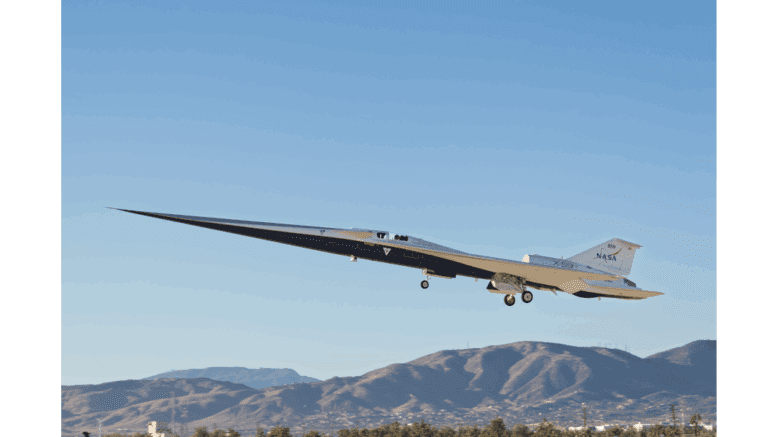Photo of X-59 provided by Lockheed Martin
Lockheed Martin Skunk Works, in partnership with NASA, has completed the first flight of the X-59, a supersonic aircraft developed to advance quieter commercial air travel. According to the company, the flight marks a milestone in efforts to reduce sonic booms, a key hurdle in enabling supersonic flight over land.
The X-59 departed from Skunk Works’ facility at U.S. Air Force Plant 42 in Palmdale, California, and landed near NASA’s Armstrong Flight Research Center in Edwards, California. According to Lockheed Martin, the aircraft performed as planned, verifying flying qualities and air-data performance.
“We are thrilled to achieve the first flight of the X-59,” said OJ Sanchez, vice president and general manager of Lockheed Martin Skunk Works. “This aircraft is a testament to the innovation and expertise of our joint team, and we are proud to be at the forefront of quiet supersonic technology development.”
The X-59 is designed to demonstrate the ability to fly at supersonic speeds while minimizing the disruptive sonic boom to what developers describe as a “gentle thump.” The goal is to support the establishment of new regulations for acceptable noise thresholds, potentially allowing supersonic commercial travel over land.
“X-59 is a symbol of American ingenuity. The American spirit knows no bounds. It’s part of our DNA – the desire to go farther, faster, and even quieter than anyone has ever gone before. This work sustains America’s place as the leader in aviation and has the potential to change the way the public flies,” said Sean Duffy, acting NASA Administrator.
Skunk Works will continue leading the aircraft’s flight test campaign in coordination with NASA. Upcoming tests will include the X-59’s first supersonic flights to determine optimal conditions for minimizing sonic impact. These data will be used in community response testing to evaluate public acceptance of quieter supersonic operations.
According to the company, the program reflects Lockheed Martin’s ongoing efforts to drive innovation in aerospace and contribute to the development of next-generation commercial flight capabilities.
What is Skunk Works?
Lockheed Martin’s Skunk Works® is the company’s Advanced Development Programs (ADP) division — a semi-autonomous organization within Lockheed Martin Aeronautics known for designing and building some of the most innovative and secretive aircraft in history.
Origins
Located in Palmdale, California, the Skunk Works was founded in 1943 during World War II by legendary engineer Clarence “Kelly” Johnson, who led a small, highly skilled team within Lockheed Aircraft Corporation. The group was formed to design the P-80 Shooting Star, America’s first operational jet fighter, under extreme time pressure and secrecy.
The name “Skunk Works” comes from a comic strip called Li’l Abner, where a backwoods still called “Skonk Works” brewed a foul-smelling concoction — the Lockheed team jokingly adopted the name because their first workspace was next to a foul-smelling plastics factory.
Notable Projects
Notable projects of Skunk Works include:
U-2 spy plane – capable of flying above 70,000 feet for reconnaissance during the Cold War.
SR-71 Blackbird – the world’s fastest air-breathing aircraft, cruising over Mach 3.
F-117 Nighthawk – the first operational stealth aircraft.
F-22 Raptor and F-35 Lightning II – cutting-edge stealth fighters for the U.S. and allied air forces.
X-59 QueSST (Quiet Supersonic Technology) – a current NASA partnership to develop a jet that can fly faster than sound without a loud sonic boom.
Lockheed Martin and Cobb County
The Lockheed Martin facility in Marietta has been a major employer in Cobb County since 1951, when the Lockheed Corporation, a predecessor of Lockheed Martin, took over the former site of the WWII Bell Bomber plant.
The C-130 program is the largest program operating at the Marietta facility. The plant currently produces the C-130J Super Hercules (see a virtual tour of the Marietta plant, or the company’s C-30J brochure for more information).
The Marietta plant also provides ongoing support for the C-5 Galaxy, which celebrated its 50th year in operation in 2018. The C-5 Galaxy is expected to remain in service until 2045.
The Marietta location also supports the P-3 Orion, and manufactures the center wings for the F-35.
